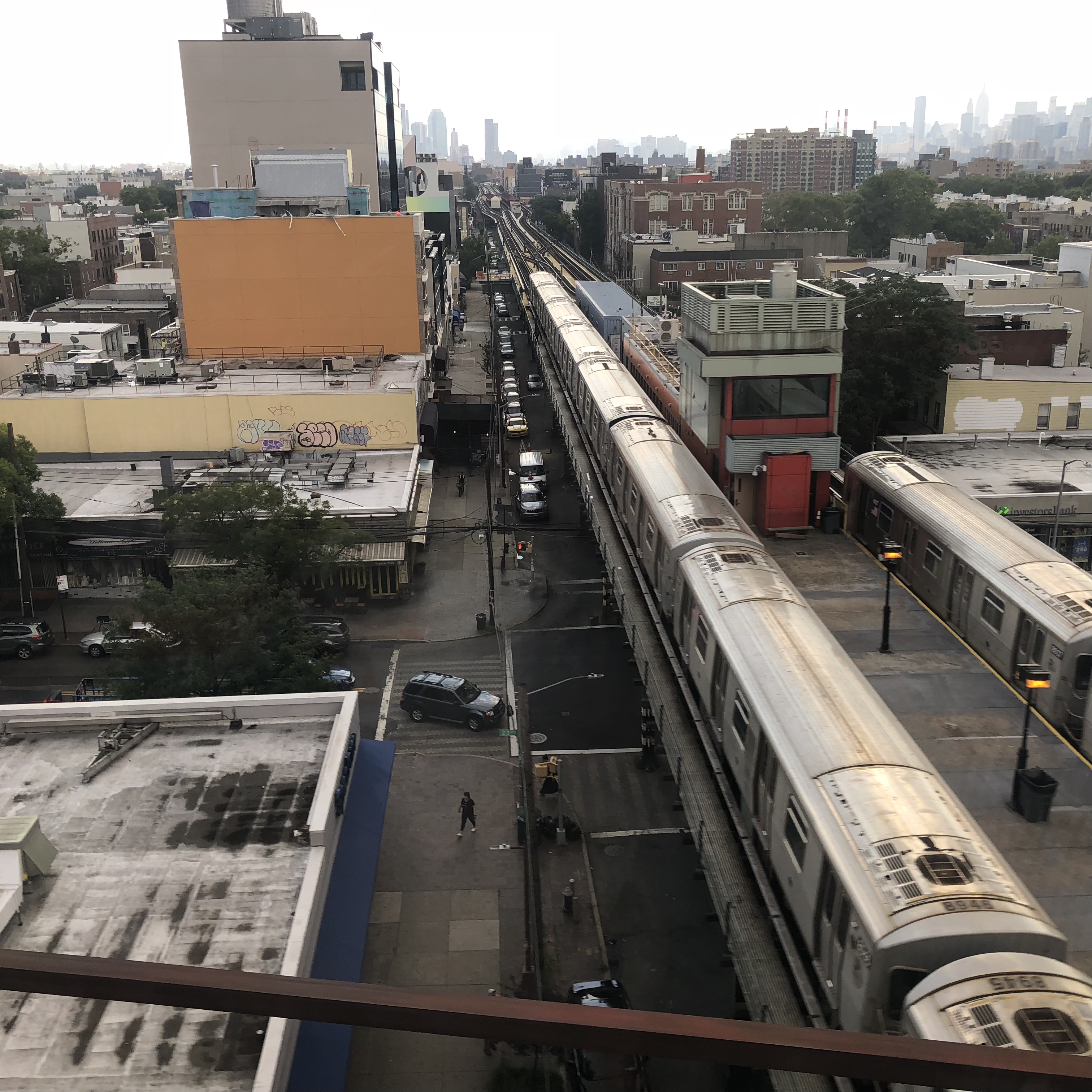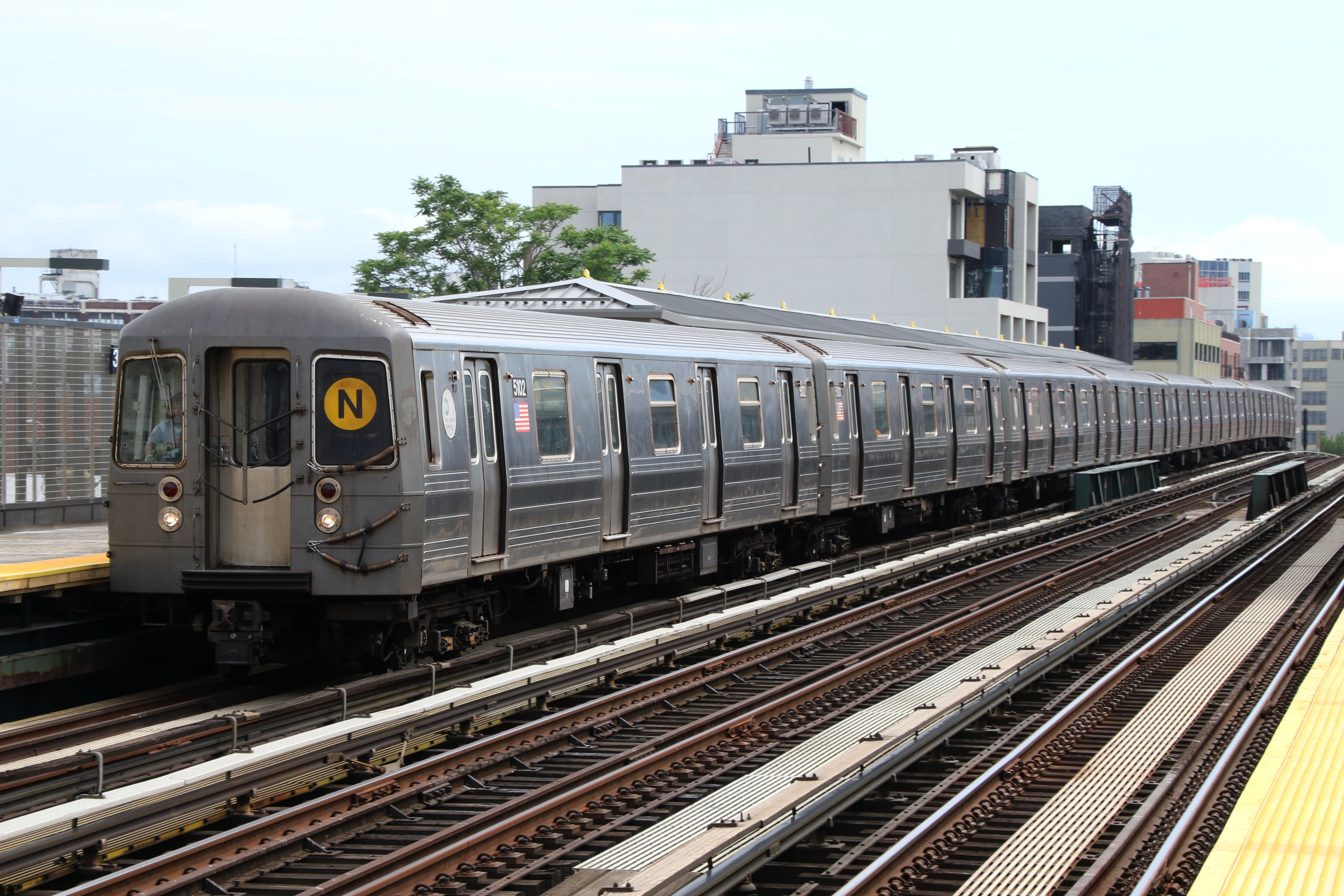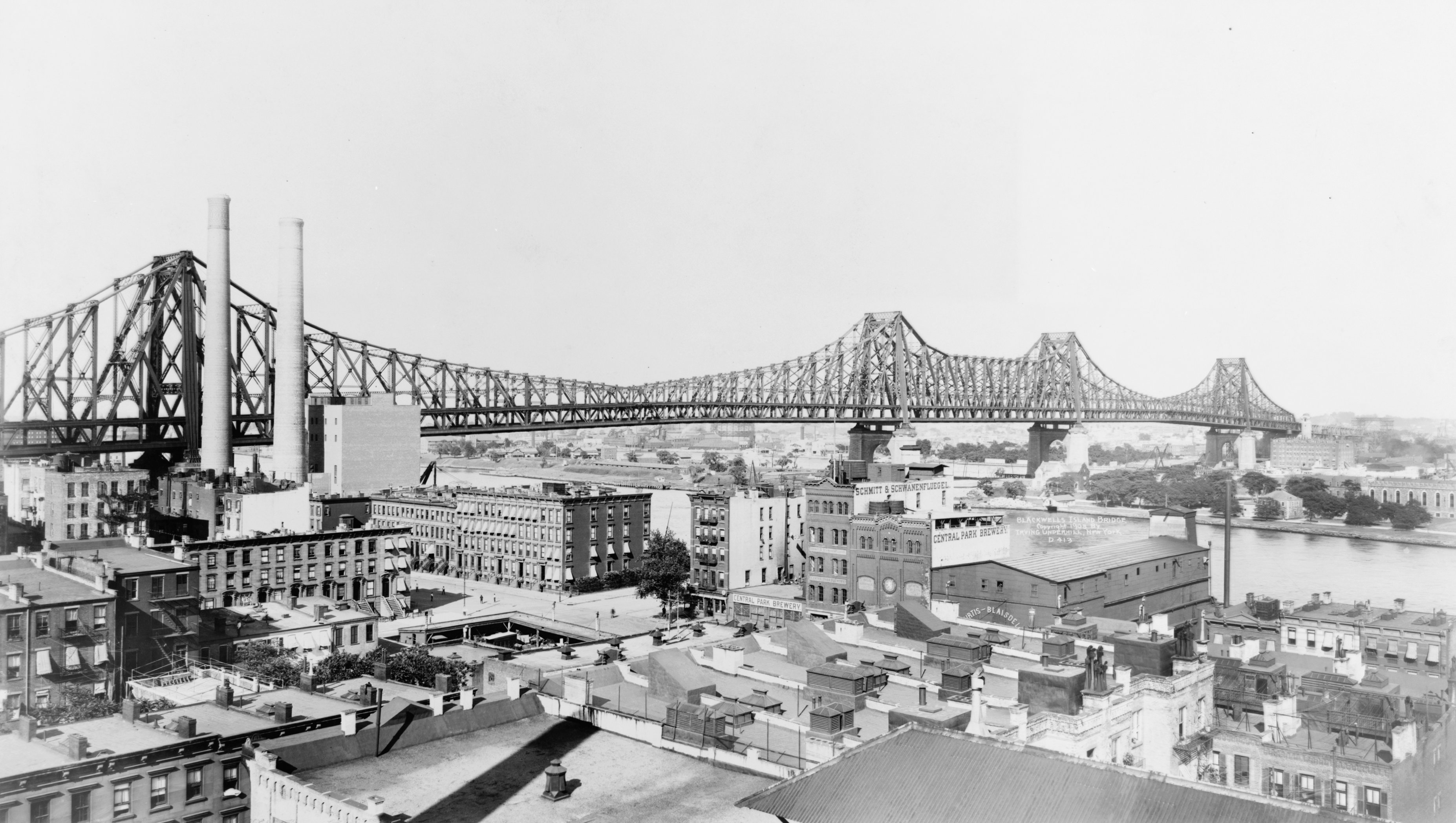|
Astoria–Ditmars Boulevard Station
The Astoria–Ditmars Boulevard station (also known as Ditmars Boulevard station), is the northern terminal station on the BMT Astoria Line of the New York City Subway. Located above 31st Street between 23rd Avenue and Ditmars Boulevard in Astoria, Queens, it is served by the N (New York City Subway service), N train at all times and the W (New York City Subway service), W train on weekdays. The Astoria–Ditmars Boulevard station opened on February 1, 1917, as part of the initial segment of the BMT Astoria Line. In 2018 and 2019, this station was renovated along with six others on the Astoria Line. This station has two tracks and an island platform. It is partially under the New York Connecting Railroad (NYCR) viaduct, which also carries the tracks of Amtrak's Northeast Corridor. Most of the platform is north of the viaduct. History Opening This station opened on February 1, 1917, along with the rest of the Astoria Line, which was originally part of the Interborough Rapid ... [...More Info...] [...Related Items...] OR: [Wikipedia] [Google] [Baidu] |
Queens
Queens is a borough of New York City, coextensive with Queens County, in the U.S. state of New York. Located on Long Island, it is the largest New York City borough by area. It is bordered by the borough of Brooklyn at the western tip of Long Island to its west, and Nassau County to its east. Queens also shares water borders with the boroughs of Manhattan, the Bronx, and Staten Island (via the Rockaways). With a population of 2,405,464 as of the 2020 census, Queens is the second most populous county in the State of New York, behind Kings County (Brooklyn), and is therefore also the second most populous of the five New York City boroughs. If Queens became a city, it would rank as the fifth most-populous in the U.S. after New York City, Los Angeles, Chicago, and Houston. Approximately 47% of the residents of Queens are foreign-born. Queens is the most linguistically diverse place on Earth and is one of the most ethnically diverse counties in the United States. Queens was est ... [...More Info...] [...Related Items...] OR: [Wikipedia] [Google] [Baidu] |
IRT Flushing Line
The IRT Flushing Line is a rapid transit route of the New York City Subway system, named for its eastern terminal in Flushing, Queens. It is operated as part of the A Division. The Interborough Rapid Transit Company (IRT), a private operator, had constructed the section of the line from Flushing, Queens, to Times Square, Manhattan between 1915 and 1928. A western extension was opened to Hudson Yards in western Manhattan in 2015, and the line now stretches from Flushing to Chelsea, Manhattan. It carries trains of the local service, as well as the express during rush hours in the peak direction. It is the only currently operational IRT line to serve Queens. It is shown in the color on station signs, the official subway map, and internal route maps in R188 cars. Before the line was opened all the way to Flushing in 1928, it was known as the Corona Line or Woodside and Corona Line. Prior to the discontinuation of BMT services in 1949, the portion of the IRT Flushing Line bet ... [...More Info...] [...Related Items...] OR: [Wikipedia] [Google] [Baidu] |
36th Avenue (BMT Astoria Line)
The 36th Avenue station (formerly known as 36th Avenue–Washington Avenue station) is a local station on the BMT Astoria Line of the New York City Subway. It is located at the intersection of 36th Avenue and 31st Street in Astoria, Queens. The station is served by the N train at all times, as well as by the W train on weekdays. The station opened along with the rest of the Astoria Line in 1917. Its platforms were extended in 1950, and the station was renovated in 2017 and 2018. History This station opened on February 1, 1917, along with the rest of the Astoria Line, which was originally part of the IRT, as a spur off the IRT Queensboro Line, which is now the IRT Flushing Line. Trains ran between Grand Central and Astoria. On July 23, 1917, the Queensboro Bridge spur of the elevated IRT Second Avenue Line opened. At that time, all elevated trains to Queensboro Plaza used the Astoria Line while all subway trains used the IRT Flushing Line, though this was later changed wi ... [...More Info...] [...Related Items...] OR: [Wikipedia] [Google] [Baidu] |
30th Avenue (BMT Astoria Line)
The 30th Avenue station (formerly 30th Avenue–Grand Avenue station) is a local station on the BMT Astoria Line of the New York City Subway. It is located at 30th Avenue and 31st Street in Astoria. The station is served by the N train at all times, as well as by the W train on weekdays. History This station opened on February 1, 1917, along with the rest of the Astoria Line, which was originally part of the IRT, as a spur off the IRT Queensboro Line, which is now the IRT Flushing Line. Trains ran between Grand Central and Astoria. On July 23, 1917, the Queensboro Bridge spur of the elevated IRT Second Avenue Line opened. At that time, all elevated trains to Queensboro Plaza used the Astoria Line while all subway trains used the IRT Flushing Line, though this was later changed with trains alternating between branches. This station started to be served by BMT shuttles using elevated cars on April 8, 1923. The city government took over the BMT's operations on June 1, 19 ... [...More Info...] [...Related Items...] OR: [Wikipedia] [Google] [Baidu] |
BMT 2
The R Broadway/Fourth Avenue Local is a rapid transit service in the B Division of the New York City Subway. Its route emblem, or "bullet", is colored since it uses the BMT Broadway Line in Manhattan. The R operates local between 71st Avenue in Forest Hills, Queens and 95th Street in Bay Ridge, Brooklyn at all times except nights, when it short turns at Whitehall Street–South Ferry in Lower Manhattan from Brooklyn. The R runs via Queens Boulevard in Queens, Broadway in Manhattan, and Fourth Avenue in Brooklyn. One northbound a.m. rush hour trip terminates at 96th Street on the Upper East Side of Manhattan instead of 71st Avenue in Queens. The R was originally the Brooklyn–Manhattan Transit Corporation's 2 service, running along the BMT Fourth Avenue Line in Brooklyn then traveling through the Montague Street Tunnel to Manhattan, then running local on the BMT Broadway Line. The 2 became the RR in 1961. The RR ran local along the BMT Astoria Line in Queens, termina ... [...More Info...] [...Related Items...] OR: [Wikipedia] [Google] [Baidu] |
BMT 1
The Q Second Avenue/Broadway Express/Brighton Local is a rapid transit service in the B Division (New York City Subway), B Division of the New York City Subway. Its route emblem, or "bullet", is colored since it uses the BMT Broadway Line in Manhattan. The Q operates at all times between 96th Street (Second Avenue Subway), 96th Street in the Upper East Side of Manhattan and Coney Island–Stillwell Avenue (BMT Brighton Line), Stillwell Avenue in Coney Island, Brooklyn, via the BMT Broadway Line, the Manhattan Bridge and the BMT Brighton Line. Daytime service makes express stops in Manhattan and local stops in Brooklyn; late night service makes local stops along its entire route. Limited rush hour service operates locally in Brooklyn via the BMT Sea Beach Line and express via the BMT Fourth Avenue Line, but only in the northbound direction. The Q was originally the Brooklyn–Manhattan Transit Corporation (BMT)'s 1 service; beginning in 1920, it ran along the Brighton Line in B ... [...More Info...] [...Related Items...] OR: [Wikipedia] [Google] [Baidu] |
Queensboro Plaza (New York City Subway)
The Queensboro Plaza station (originally named Queensboro Bridge Plaza station or simply Bridge Plaza station) is an elevated New York City Subway station at Queens Plaza (Queens), Queens Plaza (originally called Queensboro Bridge Plaza or simply Bridge Plaza) in the Long Island City neighborhood of Queens. It is near the east end of the Queensboro Bridge, with Queens Boulevard running east from the plaza. The station is served by the 7 (New York City Subway service), 7 and N (New York City Subway service), N trains at all times, the W (New York City Subway service), W train on weekdays, and the 7d (New York City Subway service), <7> train rush hours in the peak direction. Queensboro Plaza was originally built in 1916–1917 as part of the Dual Contracts between the Brooklyn–Manhattan Transit Corporation (BMT) and the Interborough Rapid Transit Company (IRT). The station initially had eight tracks to allow BMT and IRT passengers to transfer between the BMT Astori ... [...More Info...] [...Related Items...] OR: [Wikipedia] [Google] [Baidu] |
Brooklyn–Manhattan Transit Corporation
The Brooklyn–Manhattan Transit Corporation (BMT) was an urban transit holding company, based in Brooklyn, New York City, United States, and incorporated in 1923. The system was sold to the city in 1940. Today, together with the IND subway system, it forms the B Division of the modern New York City Subway. The original BMT routes currently form the , , , , , and trains, as well as the Franklin Avenue Shuttle, with the IND , , and using BMT trackage in Brooklyn. The train enters the IND via the Chrystie Street Connection after crossing the Williamsburg Bridge, the , along with some rush-hour trains enter the IND from the BMT 63rd Street Line and the train enters the IND via the 60th Street Tunnel Connection. The train supplements the in the peak direction during rush hours only. Prior to city ownership, the BMT services were designed with numbers, and the current letter scheme was developed as a continuation of the IND nomenclature as the IND and BMT systems were in ... [...More Info...] [...Related Items...] OR: [Wikipedia] [Google] [Baidu] |
The New York Times
''The New York Times'' (''the Times'', ''NYT'', or the Gray Lady) is a daily newspaper based in New York City with a worldwide readership reported in 2020 to comprise a declining 840,000 paid print subscribers, and a growing 6 million paid digital subscribers. It also is a producer of popular podcasts such as '' The Daily''. Founded in 1851 by Henry Jarvis Raymond and George Jones, it was initially published by Raymond, Jones & Company. The ''Times'' has won 132 Pulitzer Prizes, the most of any newspaper, and has long been regarded as a national " newspaper of record". For print it is ranked 18th in the world by circulation and 3rd in the U.S. The paper is owned by the New York Times Company, which is publicly traded. It has been governed by the Sulzberger family since 1896, through a dual-class share structure after its shares became publicly traded. A. G. Sulzberger, the paper's publisher and the company's chairman, is the fifth generation of the family to head the pa ... [...More Info...] [...Related Items...] OR: [Wikipedia] [Google] [Baidu] |
IRT Second Avenue Line
The IRT Second Avenue Line, also known as the Second Avenue Elevated or Second Avenue El, was an elevated railway in Manhattan, New York City, United States, from 1878 to 1942. It was operated by the Interborough Rapid Transit Company until 1940, when the city took over the IRT. Service north of the 57th Street station ended on June 11, 1940; the rest of the line closed on June 13, 1942. History In 1875, the Rapid Transit Commission granted the Gilbert Elevated Railway Company the right to construct the railway from Battery Park to the Harlem River along Second Avenue. The commission also granted the Gilbert Elevated Railway Company the right to operate the Sixth Avenue Elevated and soon afterward the Gilbert Elevated Railway changed its name to the Metropolitan Elevated Railway. Around 1900, the line was electrified. Between 1914 and 1916 construction was undertaken to install a third track to provide express service on the line during peak hours. Express service commence ... [...More Info...] [...Related Items...] OR: [Wikipedia] [Google] [Baidu] |
Elevated Railway
An elevated railway or elevated train (also known as an el train for short) is a rapid transit railway with the tracks above street level on a viaduct or other elevated structure (usually constructed from steel, cast iron, concrete, or bricks). The railway may be broad-gauge, standard-gauge or narrow-gauge railway, light rail, monorail, or a suspension railway. Elevated railways are normally found in urban areas where there would otherwise be multiple level crossings. Usually, the tracks of elevated railways that run on steel viaducts can be seen from street level. History The earliest elevated railway was the London and Greenwich Railway on a brick viaduct of 878 arches, built between 1836 and 1838. The first of the London and Blackwall Railway (1840) was also built on a viaduct. During the 1840s there were other plans for elevated railways in London that never came to fruition. From the late 1860s onward, elevated railways became popular in US cities. The New York West ... [...More Info...] [...Related Items...] OR: [Wikipedia] [Google] [Baidu] |
Queensboro Bridge
The Queensboro Bridge, officially named the Ed Koch Queensboro Bridge, is a cantilever bridge over the East River in New York City. Completed in 1909, it connects the neighborhood of Long Island City in the borough of Queens with the Upper East Side in Manhattan, passing over Roosevelt Island. The bridge is also known as the 59th Street Bridge because its Manhattan end is located between 59th and 60th streets. The Queensboro Bridge carries New York State Route 25 (NY 25), which terminates at the bridge's western end in Manhattan, and also once carried NY 24 and NY 25A. The western leg of the Queensboro Bridge is flanked on its northern side by the freestanding Roosevelt Island Tramway. The bridge was, for a long time, simply called the Queensboro Bridge, but in March 2011, the bridge was officially renamed in honor of former New York City mayor Ed Koch. The Queensboro Bridge is the northernmost of four toll-free vehicular bridges connecting Manhattan Island to Long Island, ... [...More Info...] [...Related Items...] OR: [Wikipedia] [Google] [Baidu] |






.png)

